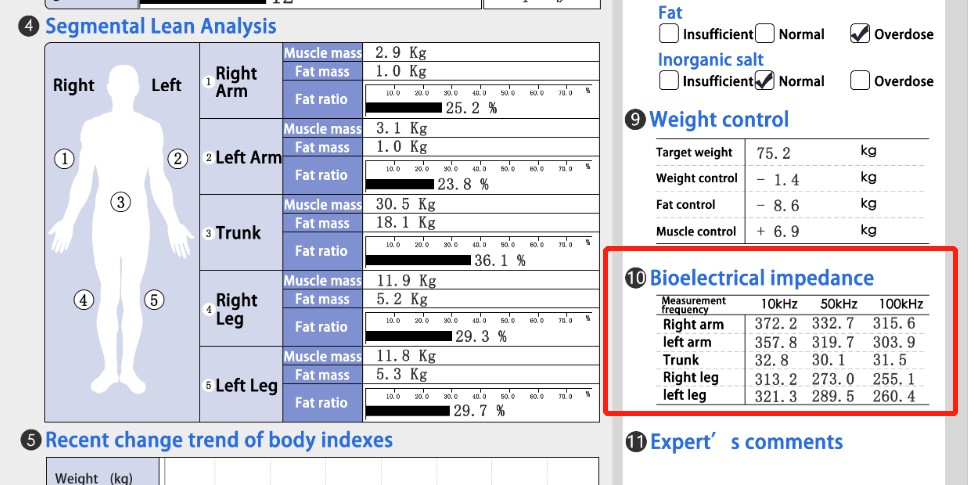
Special printing color paper for IN-F500
The printing color paper is separated from the printed content, which can be easily dealt with by a variety of ordinary black and white printers, and can be adjusted with laser printers, which can greatly save printing costs and bring the pleasure of printing results quickly .
IN-F500 professional physical examination report in Chinese and English
Through the choice of language, IN-F500 can realize the operation detection compatible with two languages, and it also supports the output and printing of the two-language test report. Output Chinese and English reports (replace the corresponding language report paper)
>> Introduction of test report <<
A. Full body examination
Weight: The maximum weight is 400kg, which can be measured by multiple people.
Body fat percentage: Indicates the percentage of fat tissue in the body. The fundamental judgment of obesity is not based on body weight, but based on body fat rate.
Body fat mass: Display the fat mass in the body by weight.
Muscle mass: the muscle tissue (skeletal muscle, smooth muscle, water) that maintains the posture and promotes the work of the heart weight.
Body water percentage: Shows the amount of water in the body such as blood, lymph fluid, intercellular fluid, and intracellular fluid.
Estimated bone mass: The amount of calcium and other minerals contained in the entire bone is called "bone mass"
※The body fat percentage is not displayed for under 17 years old. The fat mass is outside the standard range
BMI: It can be calculated by "weight/height (m)2". BM 1 is 22 when the disease is less.
B. Judge body type by body fat percentage and muscle mass
Referring to body fat percentage and muscle mass to determine body shape.
Body composition that cannot be distinguished by weight
※Under 17 years old, only the judgment result of body fat percentage is displayed. In addition, a target body fat percentage can be set.
C. BMR VFR
The measurement results are displayed in bars, which is simple and clear.
Basal Metabolism (BMR): Display and judge the basal metabolism based on measuring body composition.
Visceral fat level (VFR): Displays the fat attached to the abdominal cavity (around the internal organs) by level.
※Unable to display under 17 years old.
Extracellular fluid rate: The ratio of the amount of extracellular fluid contained in body water.
D. Body part analysis
It helps to confirm the effectiveness index of training.
Analytical value of each part of fat and muscle. Provide necessary information for body sculpting and muscle training such as numerical judgment of various parts.
※ Only measured values are displayed for persons under 17 years old.
E. Body balance
Through the fat and muscle ratio of limbs and trunk, the left and right muscles can be compared to obtain a balance check. Compare the muscles of the left and right arms and legs to check balance.
Leg muscle points
An index to determine the proportion of leg muscle mass in body weight, and to evaluate the strength of the legs that are prone to aging with age.
※Unable to display under 17 years old.
>> Understand comprehensive information of the body composition report <<
1. Body composition analysis
The human body is made up of fat, muscle, bone and water. Disorders of body components such as excessive fat or too few muscles can easily cause the "three highs" and confusion of physical conditions . Consciously measuring and managing human body composition is the basic method to create a healthy life.
Body water
The body water (body fluid) includes blood and lymph fluid, extracellular fluid, intracellular fluid, and so on. Body water is the most abundant substance in the human body. Body water can absorb nutrients, recycle waste in the body, and maintain a certain body temperature. Differing from age, gender and body fat mass, the body water ratio will change. The body water content of the elderly is reduced compared with the young. Newborns and babies are more hydrated.
Body fat percentage
The criterion for judging obesity should be body fat percentage, not body weight. When the body fat rate exceeds the normal range, it is called "obesity". Obesity is divided into two types, one is "visceral fat obesity" (apple type obesity) with excessive fat in the abdominal cavity, and the other is "subcutaneous fat obesity" (pear type obesity) with subcutaneous fat attached. Since visceral fat is more likely to induce symptoms such as "three highs" than subcutaneous fat, it is very important to prevent it.
Inorganic salt (bone mass)
Bones are human tissues closely related to muscles. Excessive weight or lack of exercise can reduce bone mass. Therefore, proper exercise and healthy eating habits should be used to increase bones.
Muscle mass
Muscles are the largest tissues of the human body, which have very important functions such as maintaining body temperature and body movements, maintaining heart beats and generating heat. Muscle mass mainly contains body water (about 55%) and protein (about 18%), accounting for about 70% of body weight. Muscles can be divided into three types: skeletal muscle, smooth muscle, and myocardium. Skeletal muscle accounts for about 40% of body weight. Muscle mass varies with age and gender.
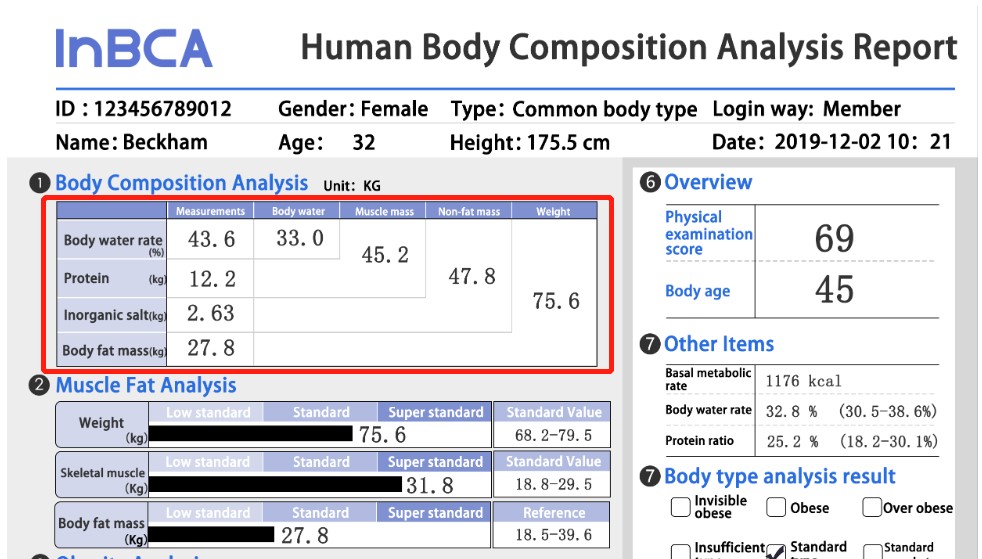
2. Muscle fat analysis
Detailed muscle and fat analysis provides clearer reference data for muscle and strength training to meet the needs of advanced bodybuilders. Comparing the data model of body weight, skeletal muscle and body fat with the standard range, the data of body motion function can be more intuitively fed back to long-term fitness enthusiasts and fitness coaches, which can carry out targeted strengthening training.
The more skeletal muscle and the less subcutaneous fat, it is usually considered the best result of bodybuilding.
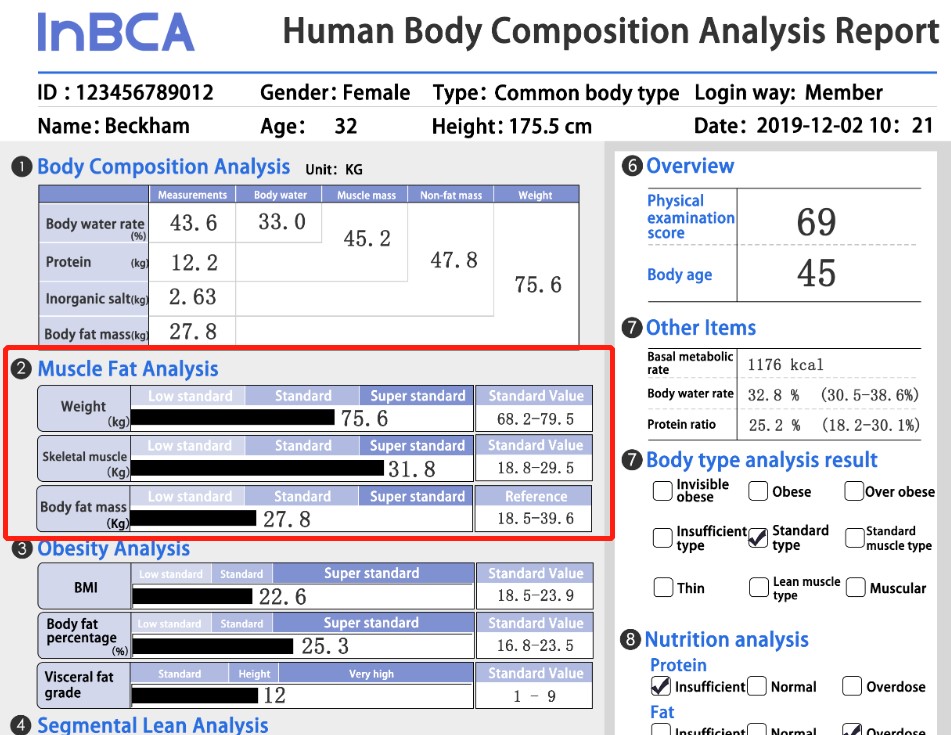
Skeletal muscle
Composed of muscle cells with contractile function, it is a type of muscle tissue (muscle tissue includes skeletal muscle, cardiac muscle and smooth muscle). It is the most tissue in the body, accounting for about 40% of body weight. In the process of exercise, skeletal muscle contraction is the driving force of human body movement. Various forms of human body movement are mainly completed by skeletal muscle contraction activities. The content of skeletal muscle is affected by factors such as gender, age and physical activity. Generally, males have more skeletal muscles than females, adults are larger than old people, and athletes are higher than ordinary people.
3. Obesity analysis
Among the many parameters of body composition, the key parameters for judging body obesity will be BMI, body fat/subcutaneous fat and visceral fat.
People who want to lose weight should pay more attention to changes in subcutaneous fat and visceral fat and return to normal, rather than only focusing on changes in weight.
Through reasonable exercise and nutrition programs, effectively change the "visceral fat obesity" and "subcutaneous fat obesity".
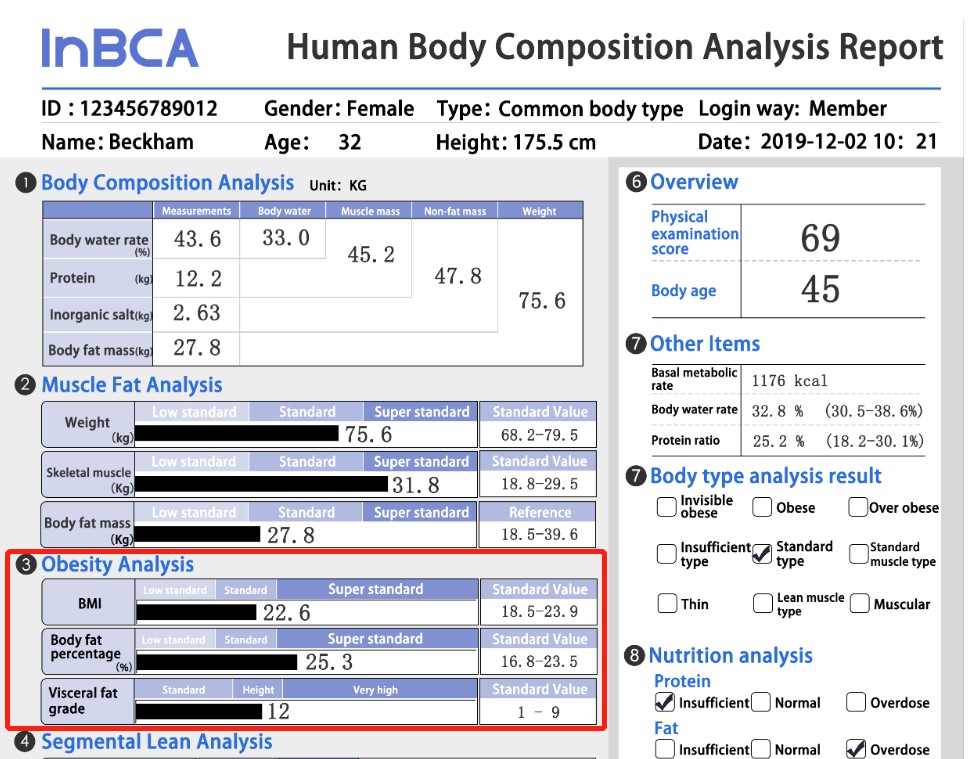
BMI
BMI=weight (kg)/height (m^2)
Body Mass Index (BMI, Body Mass Index) is an important international standard to measure the degree of human obesity and health, and is mainly used for statistical analysis.
|
Thin |
Normal |
Overweight |
Obesity |
|
|
China Evaluation Standard |
BMI ≤18.5 |
18.5≤BMI≤24.0 |
24.0≤BMI≤28.0 |
BMI≥28.0 |
Body fat percentage
Body fat percentage refers to the percentage of body fat in body weight. Body fat is divided into two types: essential fat and stored fat. Essential fat is mainly used to maintain the normal physiological functions of the body. It is mainly distributed in tissues such as nerves, muscles, bone marrow, heart, liver, and large and small intestines. Storage fat exists under the skin and In the fatty tissue around the main organs.
Visceral fat grade
Visceral fat content refers to the fat content in the human abdominal cavity, which surrounds the key human organs of the trunk. Studies have shown that even if the body weight and fat content remain stable, fat is easily transferred to the body's trunk with age, especially after menopause. Therefore, it is always ensured that the visceral fat content in the body is always at a healthy level and can be effectively reduced diseases, such as heart disease, high blood pressure and diabetes. Please pay attention to the visceral fat level for a long time, and carry out effective health management .
4. Segmental Lean Analysis
Comparing the average values of people of the same gender and physique, you can assess whether there is more or less. The results of muscle strength training and the balance between left and right can be confirmed numerically. While understanding the fat rate of various parts of the body, it is also necessary to confirm the effect of weight reduction.
Lifestyle-related diseases are closely related to it, and the fat mass of the trunk is clearly evaluated.
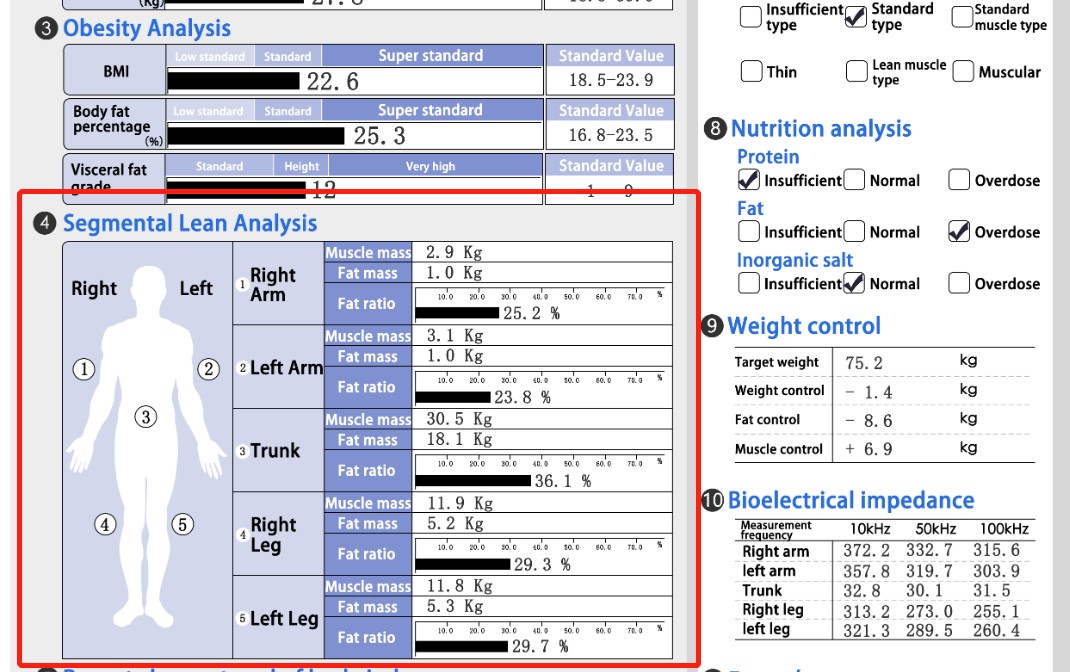
5. Recent change trend of body indexes
Sports and bodybuilders need to pay attention to change trend of body indexes for long time.
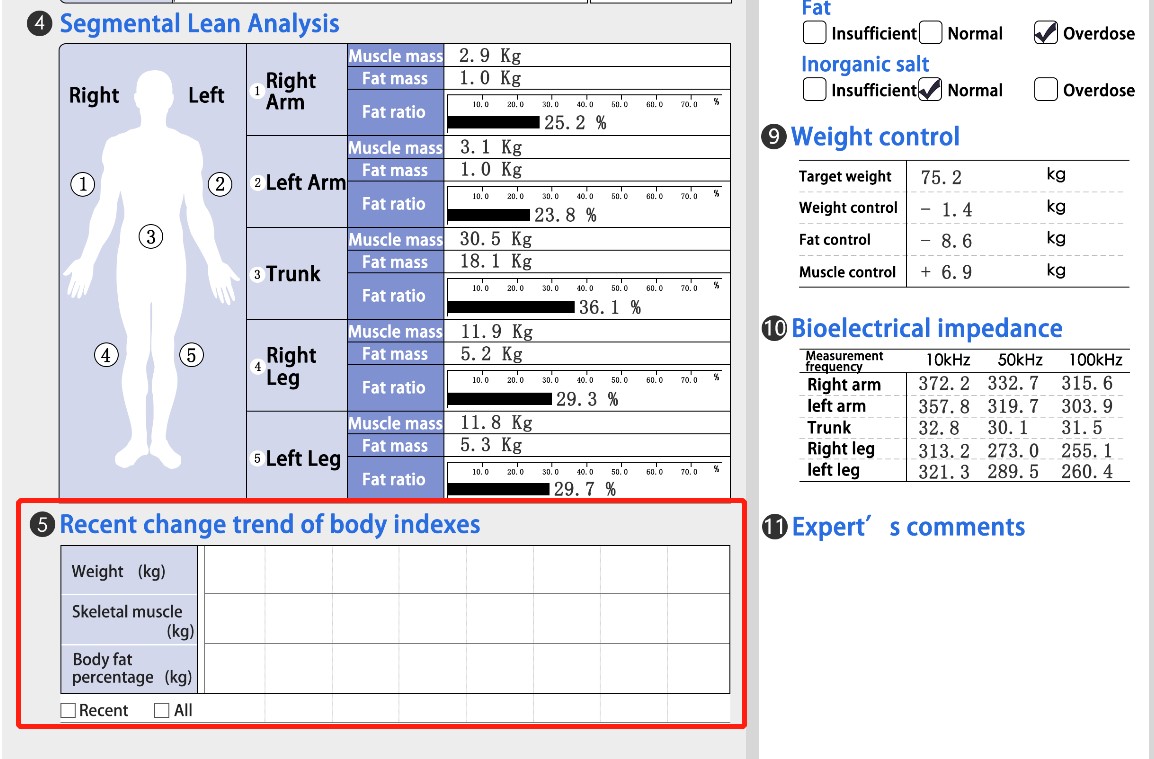
6. Overview
Physical examination score and body age, intuitively see the health of the body and which age level the body is currently equivalent to
Body age
Body age is the body age tendency calculated based on the basal metabolic rate. It is also called physiological age. It refers to the age characteristics in physiology. It represents the development level, vitality and health of the person and depends on the individual's development level, lifestyle and health status and muscularity. Therefore, the same body weight , but different body composition will change in body age . People with more muscle mass and higher basal metabolic rate are younger, and vice versa .
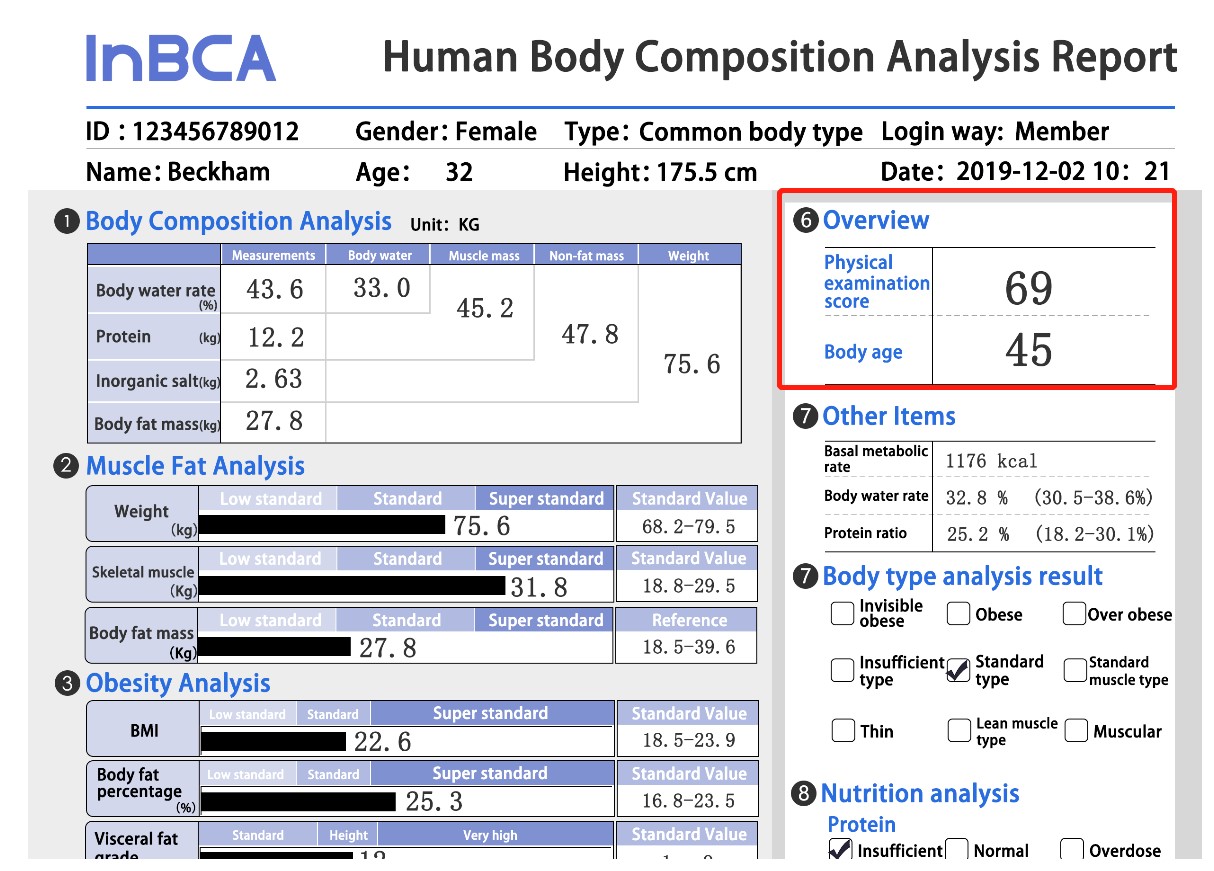
7. Other items
Basal metabolic rate
Basic metabolism (maintaining the current state of the body) is the minimum energy necessary for survival. INBCA Medical's analyzer display body composition and basal metabolism, and evaluate based on average for each age and statistics .
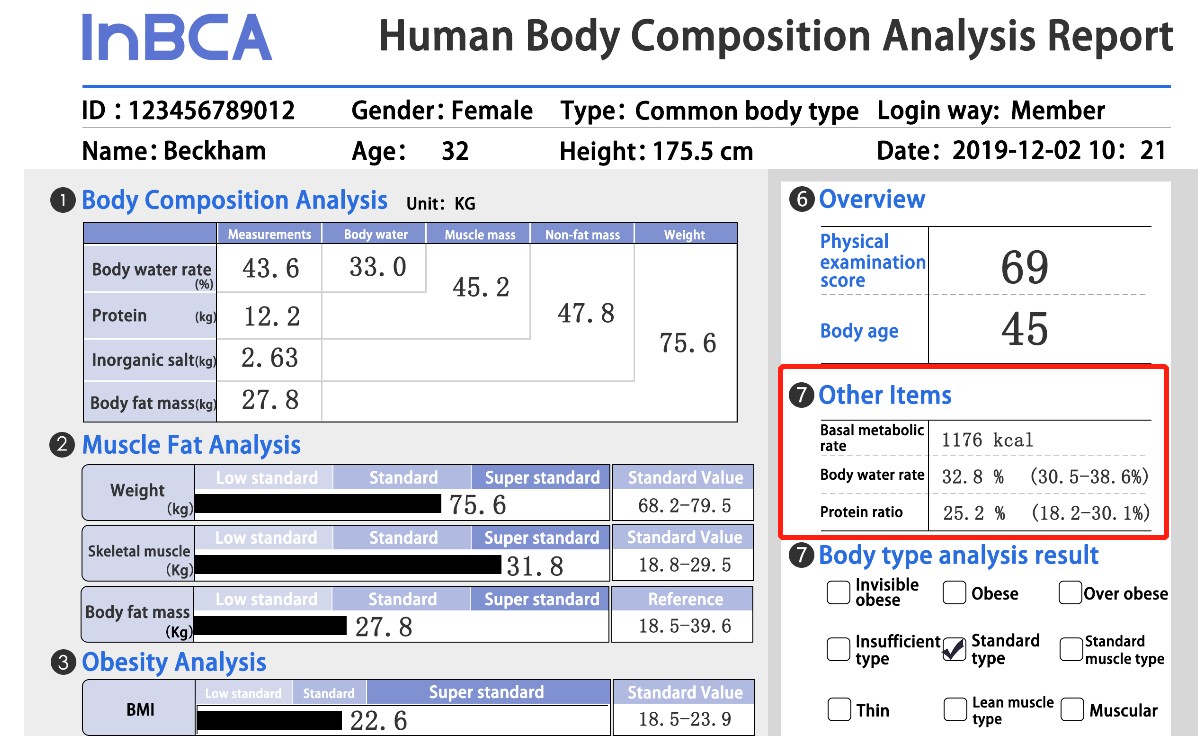
Protein rate
Protein is a biological macromolecule with amino acid as the basic unit. It is the basic material of life and participates in the formation of every cell of the body. The percentage of protein in body weight is called protein rate. Protein participates in the regulation of many important physiological processes in the body, promotes the progress of various physiological and biochemical reactions in the body, maintains the body’s acid-base balance, participates in the body’s immune regulation, maintains the body’s growth and development, tissue renewal and repair, and muscle contraction and relaxation. It can also be used as the body's energy supply material, accounting for 16% to 20% of adult body weight.
8. Body type judgment
Body type can be judged by body fat ratio and muscle mass. A person with a very low body weight but a high percentage of body fat is judged as [obese] or [hidden obesity ].
|
Body fat percentage |
Severe |
Obesity |
Invisible obesity |
Obesity type |
Over obesity type |
|
Mild |
Obese |
||||
|
Alarm |
Health |
Insufficient type |
Standard type |
Standard muscle type |
|
|
Health |
|||||
|
Thin |
Thin |
Lean |
Lean muscle type |
Muscular type |
|
|
Body fat rate range |
Less |
Average |
More |
||
|
Muscle mass |
|||||
Comprehensive body type judgment is based on body fat percentage and muscle.
Recognize the current status of body type and aim to balance body type
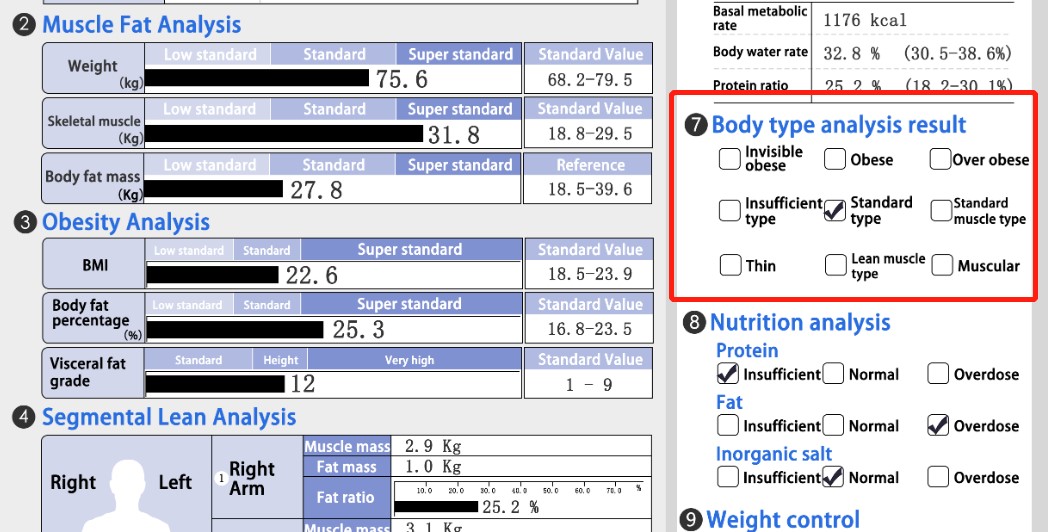
9. Nutritional assessment
Protein
Protein is one of the most important nutrients in the human body, accounting for about 16% to 20% of adult body weight. Proteins in the human body are constantly in a dynamic balance of decomposition and synthesis, and about 3% of them are renewed every day to meet tissue repair and renewal.
Body fat
Human dietary fat sources are mainly animal fats and vegetable fats.
Animal fat is rich in saturated fatty acids (40% to 60%), but the content of unsaturated fatty acids is about 30% to 50%.
Vegetable fat is rich in unsaturated fatty acids (80%~90%), but the content of saturated fatty acids is only 10%~20%. Deep-sea fish are a good source of EPA and DHA. Foods that contain more phospholipids are egg yolk, liver, soybeans, peanuts, and wheat germ. Foods rich in cholesterol are organ meats and eggs.
Inorganic salt
Insufficient bone mineral content is manifested by decreased bone quality, changes in bone microstructure, brittle bone, bone pain, and muscle weakness. To increase the amount of bone salt, it is necessary to correct bad habits, ensure adequate sleep, and take appropriate physical exercises.
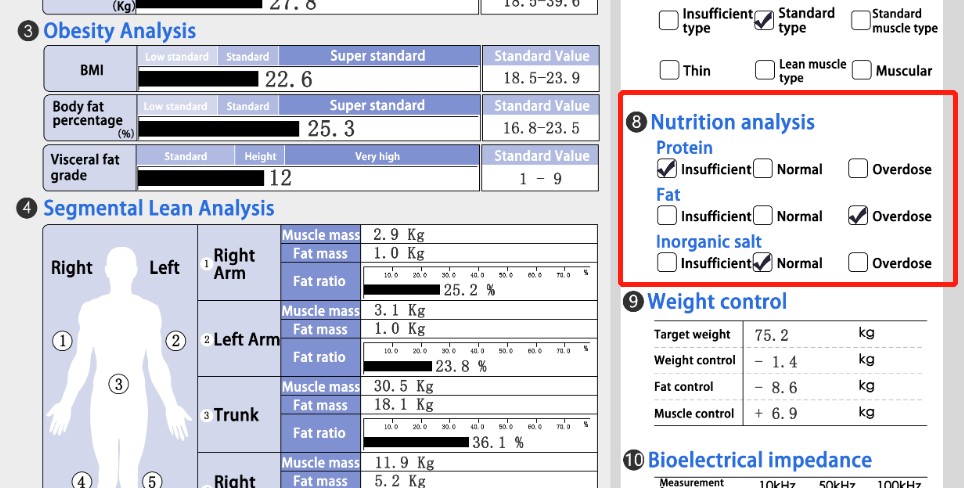
10. Weight control
To achieve a more perfect body, even if there is no professional fitness coach, you can also arrange your own fitness goals and plans through the intuitive weight control parameter goals we offer.
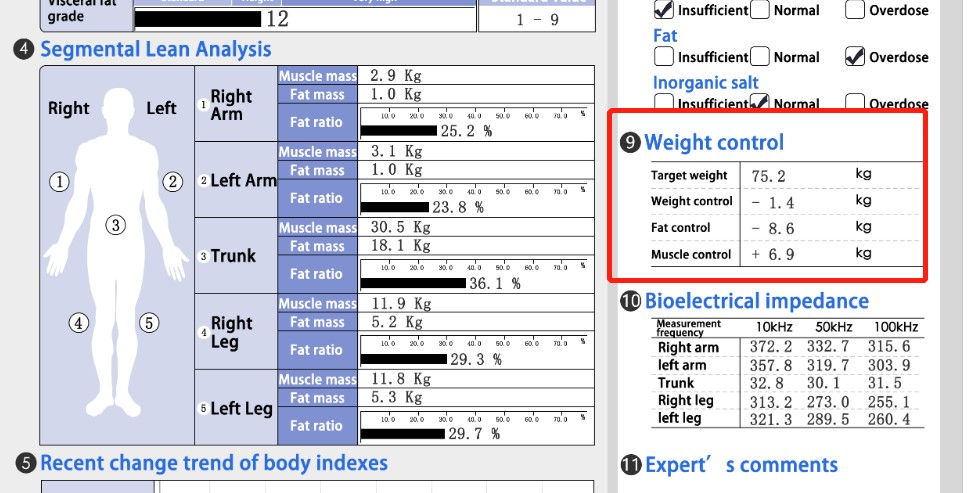
11. Bioelectrical impedance
The human body resistance value is measured under each frequency band through the DSM-BIA detection method.
